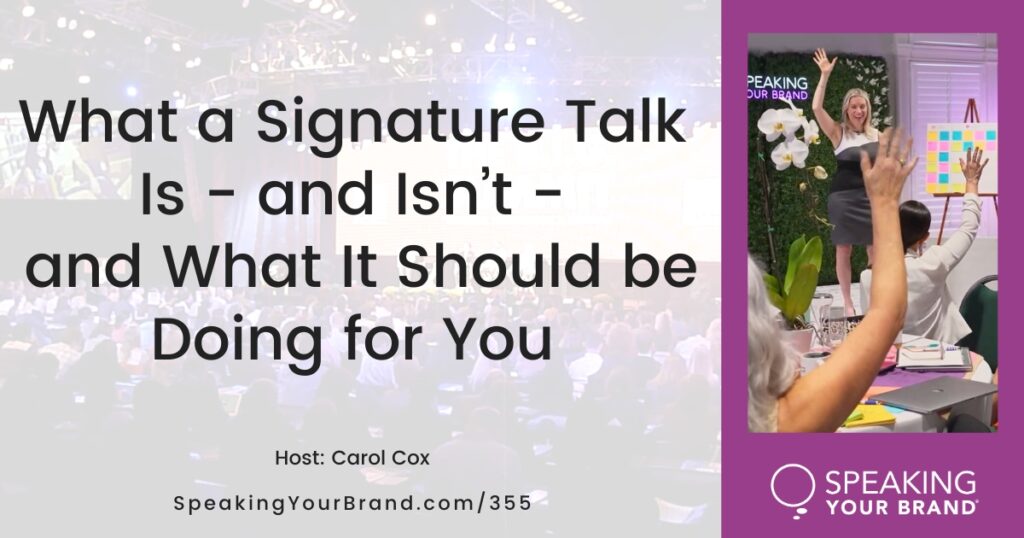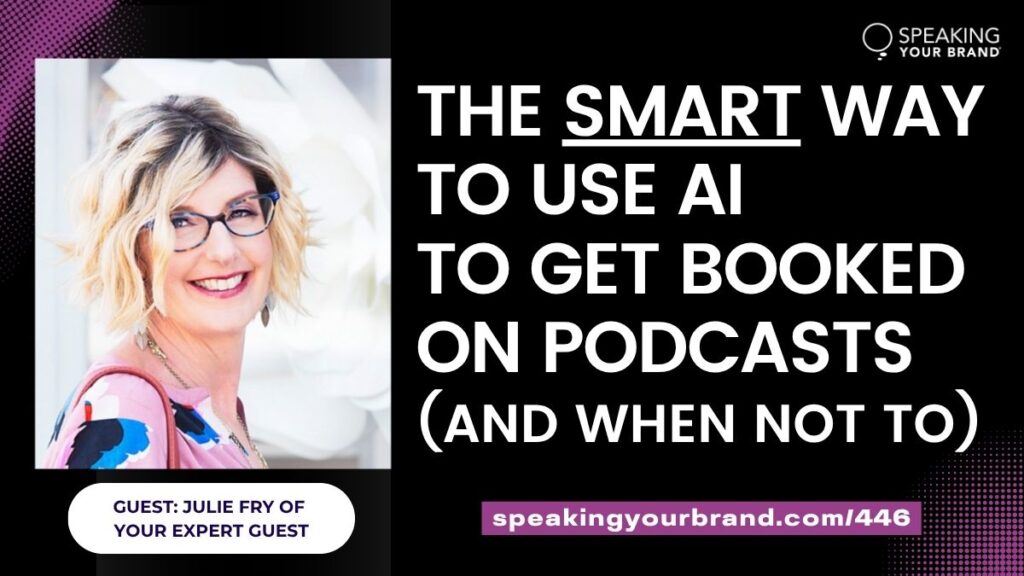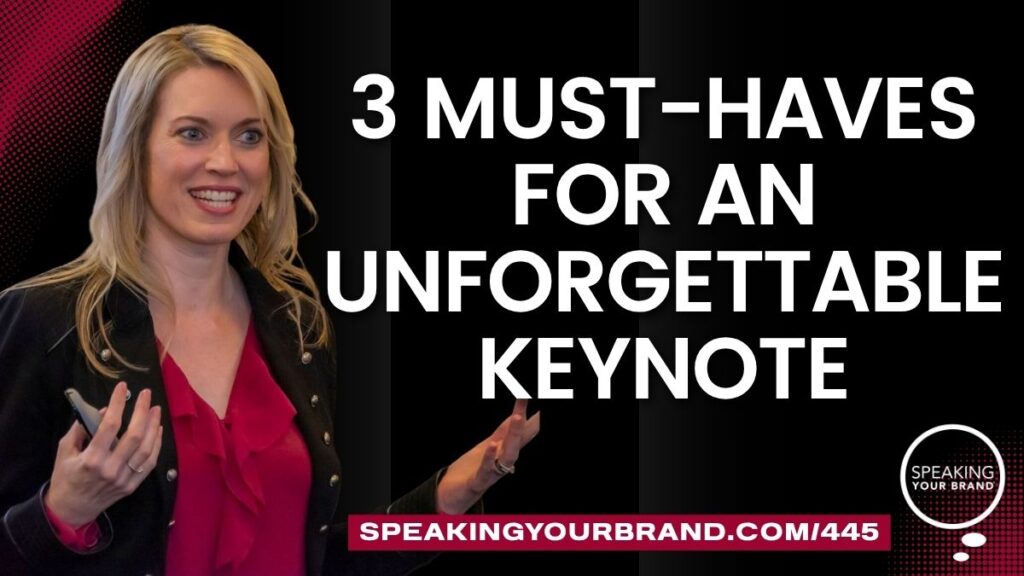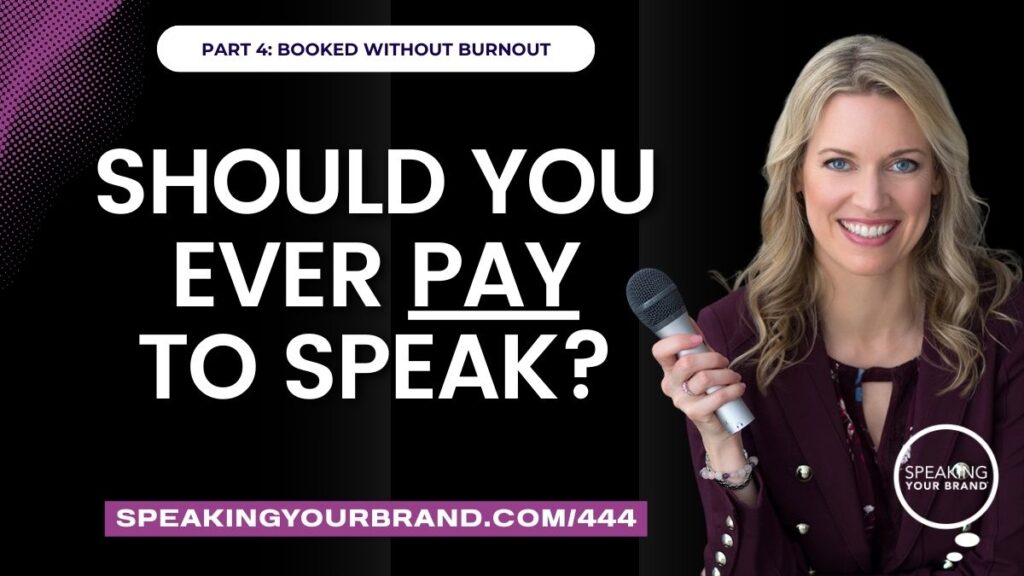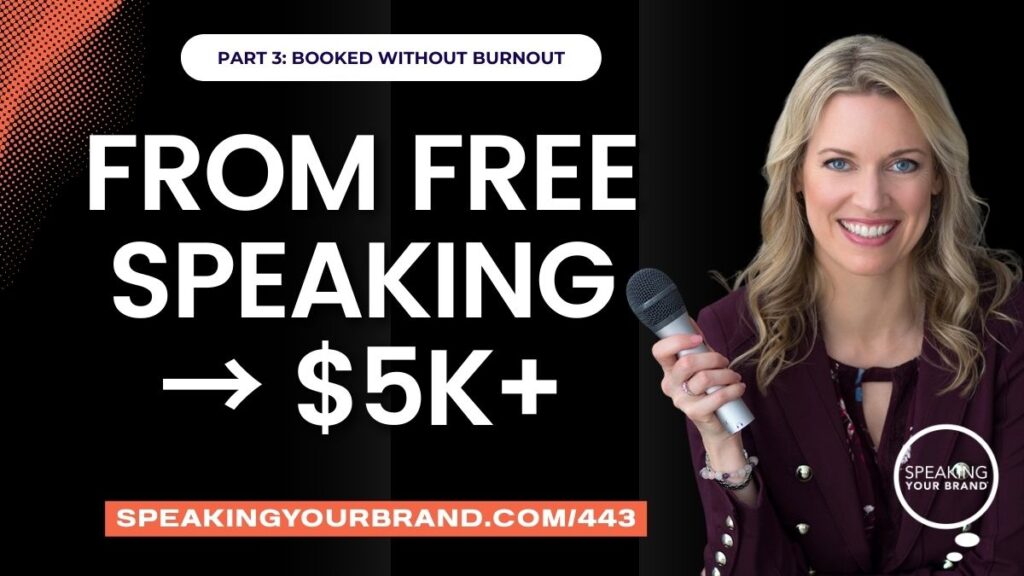355-SYB-Solo-SignatureTalk.mp3: this mp3 audio file was automatically transcribed by Sonix with the best speech-to-text algorithms. This transcript may contain errors.
Carol Cox:
Were diving into what a signature talk is and what it isn’t, and what it should be doing for you on this episode of the Speaking Your Brand podcast.
Carol Cox:
More and more women are making an impact by starting businesses, running for office and speaking up for what matters. With my background as a political analyst, entrepreneur, and speaker, I interview and coach purpose driven women to shape their brands, grow their companies, and become recognized as influencers in their field. This is speaking your brand, your place to learn how to persuasively communicate your message to your audience.
Carol Cox:
Hi there and welcome to the Speaking Your Brand podcast. I’m your host, Carol Cox. We’re continuing our new podcast series on thought leadership so that you are ready to go for 2024. Last week’s episode, I talked about how to find and develop your big idea. An idea idea is an acronym you can use. The week before that, we had an interview with one of our thought Leader Academy grads, Sharon Erlich, on her signature talk and how she used our signature Talk Canvas framework to help her create a brand new presentation. So today, we’re going to take a look at exactly what a signature talk is and what it isn’t, and what it should be doing for you. Knowing what you talk about, what will resonate with your audiences, and what will be of interest to event organizers is crucial for you to develop as a speaker and thought leader, and for you to feel confident in your content, to feel confident in your material.
Carol Cox:
And I know that you have a lot of different ideas and content pieces that you could include in your presentations, in your signature talk, and you may not be sure what to include or how to put it together in a cohesive way. Now, your signature talk isn’t a bunch of information on your topic. Your signature talk has a specific purpose for you and for your audience. Your signature talk should be doing something for you. That’s what I want to make sure that you take away from this episode, is that you’re not there in front of the audience, just to pass along information or to provide training to your audience unless you’re doing a workshop. So a specifically formatted as a workshop. And if you are, that’s great. And you should be getting paid for that. If you’re doing workshops, if you’re doing training, you should be getting paid for that. That’s one of the things we talk about in the Thought Leader Academy in our Business of Speaking module. But just relaying a bunch of information to your audience is where I see speakers get stuck. And what I call the expert trap is that you think you have to train and teach in order to provide value. But I argue that when you’re speaking at a conference or to a local group, like a business group or a chamber of commerce or a nonprofit, or you’re delivering a keynote, you’re there to provide and to share an experience with the audience, to get them to think about something in a new or different way, not just to relay a bunch of information to them.
Carol Cox:
And your signature talk should be doing something for you as well. So we’re going to get into that in just a little bit. In my definition, a signature talk combines your expertise. So that’s the what with your thought leadership. That’s the why with your personal brand. And that’s the who you you are the face and voice of your thought leadership. And so I’m going to share with you at the end of the episode the signature talk that I’m working on now, if you’re new to speaking your brand, welcome. I’m so glad that you’re here. We’ve worked with hundreds of women entrepreneurs and speakers over the years to develop their thought leadership and to create their signature talk, whether they’re doing it as a TEDx talk, a keynote, a business presentation, or a conference breakout session. Our mission is to get more women on stages in the media, on boards, in politics, and in businesses, because we know is through women’s voices and experiences that we challenge and change the status quo. We primarily work with our clients in our Thought Leader Academy. We’re enrolling now for our next start date in January.
Carol Cox:
You can get all of the details as speaking your brand.com/academy again that’s speaking your brand.com/academy is limited to eight women. And we work with you both in a small group and one on one. I’m going to tell you a little bit more about the Thought Leader Academy at the end of today’s episode. Now let’s get on with the show. As I mentioned in the intro, your signature talk should be doing something for you. And this again is where I see so many speakers go wrong where they feel like just being the teacher, just being a trainer is enough. And it’s not because your signature talk should be conveying brand awareness to your audience. It also could be doing lead generation for you, no matter what type of talk that you’re giving, whether it’s a keynote, a business presentation, a conference, breakout session, and so on, you should be planting seeds in your talk to let people know what exactly it is that you do. And you don’t have to do this with a direct sales pitch at all. But there are ways to do this effectively, and that’s one of the things that we help our clients with. Your signature talk, of course, should also be getting your message in front of more people and in a way that they remember it. And then they pass it along. They share it with others. I talked about your big idea in last week’s episode, so if you haven’t listened to last week’s episode, definitely go back and listen to that, because the elements that make up a transformative signature talk are your expertise, your big idea, your framework, and your personal journey or your personal story.
Carol Cox:
And so, of course, you start with your area of expertise. When you think about what exactly it is that you want to be talking about. So your area of expertise in your business or in your career or in your job, you also think about what is it that you want to be known for. So when someone thinks about women’s voices and women in public speaking, I want them to think about me. So that’s the content. Those are the signature talks that I put out into the world. It doesn’t just stop there. So it’s not just about your area of expertise and kind of you being this go to expert on on your topic. Instead, you need to dig deeper. You want to provide your audience with more. You also want to share insights, insights that you’ve gained from those hard won life lessons, those hard won career lessons or business lessons. Where are those insights that you’ve learned that you can share with your audience? You also want to bake into your signature talk what you do or believe that’s different from others in your industry, different from other people who talk on your topic or what you do or believe that’s that others aren’t seeing so that you have a unique perspective either based on your experience or clients that you’ve worked with that you can then share.
Carol Cox:
So part of this difference could also be your framework, your methodology, your process, your approach. So then how do you put this all together. You have your expertise your big idea, your framework. Maybe you have some personal stories, your personal journey, these insights, these hard won life lessons, what you do or believe that’s different. How do you put this all together? Well, this is why I created our signature Talk Canvas framework years ago, because I found that as I was working with my first set of clients back when I started speaking your brand, I would end up asking them a variation of very similar questions, because I knew I needed to get certain information from them in order to create a talk that took their audience on a journey and was compelling and impactful. So as I started seeing all these commonalities, I created this framework. It’s based on three act story structure because as humans, that’s what we’re used to. That’s what helps us to remember information and to process information. So it’s based on three act story structure. And then it takes your audience on a journey. You validate that you understand where they are. You understand where they want to go and what’s getting them stuck.
Carol Cox:
And you also show them why you’re credible to be talking about this topic. And so in the signature Talk Canvas framework, it’s laid out. We do it on a poster board and then it’s three different acts. So like three swim lanes. Act one, act two, act three. And then we use four different colored post-it notes because we want to make sure in your signature talk that you have a balance of your key points or like one of those main things, you want to make sure your audience knows you’re supporting points, your stories and client examples and audience engagement. So that’s why we use those four colors as we’re working on the talk. I’m going to share with you now what goes into each of these three acts. You can get this information in our free Thought Leadership Guide in workbook. One of the pages shows our signature Talk Canvas framework, and you can get this free guide at speaking your brand.com/guide. Again, that’s speaking your brand.com/guide. Act one I call the issue. So like what is the issue your audience is facing or what is the issue that you want to bring to light. So act one is all about understanding what is the audience want related to your topic? What’s getting in their way? What’s that real problem that you see is in their way that they may not necessarily see? And what is your bio, your background, your credibility as far as why you’re there talking about that? So that’s all in act one, you’re setting up the situation and then in act two it’s okay.
Carol Cox:
You’ve identified the real problem. Now how are you going to solve it? Act two is all about your big idea your methodology, your approach, your framework, your. Crosses to help your audience get through that real problem to the goal that they have. So in act two is where you talk about your framework. Maybe you dive deep into 1 or 2 pieces of your framework, and then you share that with your audience, along with examples and maybe some activities that they can do. And then act three is inspiration. So you’re wrapping up the talk. You’re providing that resolution. You’re giving the audience the next steps that they can do on their own. And then you are mentioning your offer, your call to action, if that’s something that if you’re doing this talk for lead generation, if you’re not doing the talk directly for lead generation, you still want to give your audience a call to action, something that they can do based on this idea that you just presented to them and then you. I always like to end the talk with inspiration, with motivation, because you want people to feel empowered and like their actions can make a difference. So go back to last week’s episode on finding and developing your big idea to hear more about that.
Carol Cox:
So that’s our signature Talk Canvas framework. I use it for every presentation that I give. We use it with all of our clients in a really does help in a way that nothing else does, to take all of those ideas that are in your head and literally put them out into a flow, into something cohesive, and then you take that and then put it into an outline and then two slides and then so on. So this is the process that we go through in the Thought Leader Academy. A few weeks ago, we had one of our thought leader Academy grads, Sharon Erlich, on the podcast, and she talked about how in her VIP day with Diane Diaz, our lead speaking coach, they worked on Sharon’s signature talk together. And then a week before Sharon was set to deliver an in-person speaking engagement, the event organizer changed the topic on Sharon. So then Sharon had to create a new talk, using a lot of the elements that she and Diane had created for the original topic, but then had to create a new one. But she used our framework to do that, and she said within an hour she had her new outline done. We had some other thought leader Academy grads on this podcast back in July and August, who also talked about their own topics, their own big ideas, their own stories, and how having this framework really helped them put it together in a cohesive way.
Carol Cox:
Now, as I’ve been mentioning, your signature talk should be doing something for you. So the brand awareness, the lead generation, thought leadership. But you can also repurpose your signature talk in multiple ways. So of course you can deliver it at speaking engagements. You can make it longer into a paid workshop. You can convert it into a sales webinar. You can even take your core idea and turn it into a Ted talk. Of course, then you’re primed to create your speaking proposals and pitches. I’ve had clients use elements of their signature talk for website copy, for email nurture sequences, for social media posts, to create a lead magnet to create an entire course based on what we came up with, with their idea and framework, and to create an outline for their book. So your signature talk really becomes the foundation for your thought leadership and so much that you’re going to put out into the world. Now, you may be thinking to yourself that you have more than one idea, so can you have more than one signature talk? And I think you can. Now, there may be other people out there who think that you should just have one talk, one talk that you give, and that’s it. And I personally find that a little bit limiting. Like I like to have different topics that I talk about.
Carol Cox:
They’re all related to what we do under Speaking Your brand. So I have a signature talk around the transformative power of using our voices, especially as women. I have another signature talk around the impact and use of storytelling in business. So I have these different ones. Number one, because I have different interests, but also then it allows me to touch on these different areas depending on who the audience is and depending on what the event is. So you can absolutely have more than one signature talk. I would say that they all should kind of fall under your umbrella of your business or your career. Now, I mentioned in the intro that I was going to share with you what I’m working on now for my next signature talk. Back in earlier this summer, I gave a talk at McCann, a marketing conference around Brand Voice and I. So I’m expanding on that talk that I gave. I want to give it to more conferences next year about how in this age of AI, we can navigate our brand voice and brand authenticity. So here’s my blurb about this talk. In a world where consumers are increasingly seeking genuine connections and authenticity, understanding how to navigate the AI landscape without losing your brand soul is paramount. You’ll leave with a renewed appreciation for the power of brand voice, actionable strategies to implement, and a vision for the future of branding in an AI driven world.
Carol Cox:
So that’s the idea behind the signature talk that I’m working on that also, hopefully I’ll be turning into a book now, if you would like to work with us to develop your thought leadership, your big idea, and to create your signature talk, we’re enrolling now. Offer a Thought Leader Academy for our next start date in January. As part of the Thought Leader Academy, you get a one on one or virtual VIP day where we spend three hours together, either myself or Diane Diaz, our lead speaking coach, where we literally map out your signature talk from beginning to end using our framework, using that poster board with the colored post-it notes so that you know exactly what you’re talking about from your opening to your closing and everything in between. You also get eight weekly group zoom calls. It’s a small group, only eight women. And through those group zoom calls, we help you to work on your thought leadership message. We talk about how to tell great stories, help you identify your stories. The business of speaking. We talk about speaking proposals and speaker fees and speaker contracts. We also look at how to find speaking engagements, how to market yourself as a speaker, how to add layers to your talk to make it more memorable, and of course, preparing for and delivering your talk. At the end of the Thought Leader Academy, we always send a survey to the women who just graduated, and let me share with you some of the things that they said.
Carol Cox:
So one woman said, quote, my goals were to learn to craft my signature talk and truly understand my audience and how to speak to them effectively. Learning the signature Talk Canvas framework on how to build a talk was incredibly beneficial. The Thought Leader Academy gave me a repeatable process that I can use throughout my career. Another graduate said, quote, I joined because I needed help organizing my thoughts in order to create a coherent message and a compelling talk. The signature Talk Canvas framework has been the most useful. The power of frameworks was a revelation. My fear of writing a talk has been minimized. I no longer feel that I need weeks to write. I can now use that time I’ve gained for refining my presentation and delivery. And then another grad said, quote, this was one of the best coaching experiences I have ever had. I would encourage others to join the Thought Leader Academy. Carol and Diane delivered on everything listed in the program. If you would like to join us and the Thought Leader Academy again, our next start date is in January. We’re taking applications and we’re enrolling right now. You can get all the details, including pricing a speaking your brand.com/academy. Again that’s speaking your brand.com/academy. Until next time. Thanks for listening.
Sonix has many features that you’d love including secure transcription and file storage, world-class support, enterprise-grade admin tools, transcribe multiple languages, and easily transcribe your Zoom meetings. Try Sonix for free today.

